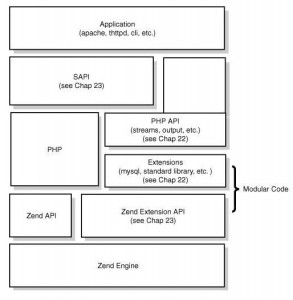深入理解php中的Zend SAPI
《转载文章》
SAPI: Server abstraction API,研究过PHP架构的同学应该知道这个东东的重要性,它提供了一个接口,使得PHP可以和其他应用进行交互数据。 本文不会详细介绍每个PHP的SAPI,只是针对最简单的CGI SAPI,来说明SAPI的机制。
首先,我们来看看PHP的架构图:
SAPI提供了一个和外部通信的接口, 对于PHP5.2,默认提供了很多种SAPI,
常见的给apache的mod_php5,CGI,给IIS的ISAPI,还有Shell的CLI,本文就从CGI SAPI入手
,介绍SAPI的机制。 虽然CGI简单,但是不用担心,它包含了绝大部分内容,足以让你深刻理解SAPI的工作原理。
要定义个SAPI,首先要定义个sapi_module_struct, 查看 PHP-SRC/sapi/cgi/cgi_main.c:
1 */ 2 static sapi_module_struct cgi_sapi_module = { 3 #if PHP_FASTCGI 4 "cgi-fcgi", /* name */ 5 "CGI/FastCGI", /* pretty name */ 6 #else 7 "cgi", /* name */ 8 "CGI", /* pretty name */ 9 #endif 10 11 php_cgi_startup, /* startup */ 12 php_module_shutdown_wrapper, /* shutdown */ 13 14 NULL, /* activate */ 15 sapi_cgi_deactivate, /* deactivate */ 16 17 sapi_cgibin_ub_write, /* unbuffered write */ 18 sapi_cgibin_flush, /* flush */ 19 NULL, /* get uid */ 20 sapi_cgibin_getenv, /* getenv */ 21 22 php_error, /* error handler */ 23 24 NULL, /* header handler */ 25 sapi_cgi_send_headers, /* send headers handler */ 26 NULL, /* send header handler */ 27 28 sapi_cgi_read_post, /* read POST data */ 29 sapi_cgi_read_cookies, /* read Cookies */ 30 31 sapi_cgi_register_variables, /* register server variables */ 32 sapi_cgi_log_message, /* Log message */ 33 NULL, /* Get request time */ 34 35 STANDARD_SAPI_MODULE_PROPERTIES 36 };
这个结构,包含了一些常量,比如name, 这个会在我们调用php_info()的时候被使用。一些初始化,收尾函数,以及一些函数指针,用来告诉Zend,如何获取,和输出数据。
- 1. php_cgi_startup, 当一个应用要调用PHP的时候,这个函数会被调用,对于CGI来说,它只是简单的调用了PHP的初始化函数:
1 static int php_cgi_startup(sapi_module_struct *sapi_module) 2 { 3 if (php_module_startup(sapi_module, NULL, 0) == FAILURE) { 4 return FAILURE; 5 } 6 return SUCCESS; 7 } 8
- 2. php_module_shutdown_wrapper , 一个对PHP关闭函数的简单包装。只是简单的调用php_module_shutdown;
- 3. PHP会在每个request的时候,处理一些初始化,资源分配的事务。这部分就是activate字段要定义的,从上面的结构我们可以看出,对于CGI 来说,它并没有提供初始化处理句柄。对于mod_php来说,那就不同了,他要在apache的pool中注册资源析构函数, 申请空间, 初始化环境变量,等等等等。
4. sapi_cgi_deactivate, 这个是对应与activate的函数,顾名思义,它会提供一个handler, 用来处理收尾工作,对于CGI来说,他只是简单的刷新缓冲区,用以保证用户在Zend关闭前得到所有的输出数据:
1 static int sapi_cgi_deactivate(TSRMLS_D) 2 { 3 /* flush only when SAPI was started. The reasons are: 4 1. SAPI Deactivate is called from two places: module init and request shutdown 5 2. When the first call occurs and the request is not set up, flush fails on 6 FastCGI. 7 */ 8 if (SG(sapi_started)) { 9 sapi_cgibin_flush(SG(server_context)); 10 } 11 return SUCCESS; 12 }
5. sapi_cgibin_ub_write, 这个hanlder告诉了Zend,如何输出数据,对于mod_php来说,这个函数提供了一个向response数据写的接口,而对于CGI来说,只是简单的写到stdout:
1 static inline size_t sapi_cgibin_single_write(const char *str, uint str_length TSRMLS_DC) 2 { 3 #ifdef PHP_WRITE_STDOUT 4 long ret; 5 #else 6 size_t ret; 7 #endif 8 #if PHP_FASTCGI 9 if (fcgi_is_fastcgi()) { 10 fcgi_request *request = (fcgi_request*) SG(server_context); 11 long ret = fcgi_write(request, FCGI_STDOUT, str, str_length); 12 if (ret <= 0) { 13 return 0; 14 } 15 return ret; 16 } 17 #endif 18 #ifdef PHP_WRITE_STDOUT 19 ret = write(STDOUT_FILENO, str, str_length); 20 if (ret <= 0) return 0; 21 return ret; 22 #else 23 ret = fwrite(str, 1, MIN(str_length, 16384), stdout); 24 return ret; 25 #endif 26 } 27 static int sapi_cgibin_ub_write(const char *str, uint str_length TSRMLS_DC) 28 { 29 const char *ptr = str; 30 uint remaining = str_length; 31 size_t ret; 32 while (remaining > 0) { 33 ret = sapi_cgibin_single_write(ptr, remaining TSRMLS_CC); 34 if (!ret) { 35 php_handle_aborted_connection(); 36 return str_length - remaining; 37 } 38 ptr += ret; 39 remaining -= ret; 40 } 41 return str_length; 42 }
把真正的写的逻辑剥离出来,就是为了简单实现兼容fastcgi的写方式。
- 6. sapi_cgibin_flush, 这个是提供给zend的刷新缓存的函数句柄,对于CGI来说,只是简单的调用系统提供的fflush;
- 7.NULL, 这部分用来让Zend可以验证一个要执行脚本文件的state,从而判断文件是否据有执行权限等等,CGI没有提供。
8. sapi_cgibin_getenv, 为Zend提供了一个根据name来查找环境变量的接口,对于mod_php5来说,当我们在脚本中调用getenv的时候,就会间接的调用这个句柄。而 对于CGI来说,因为他的运行机制和CLI很类似,直接调用父级是Shell, 所以,只是简单的调用了系统提供的genenv:
1 static char *sapi_cgibin_getenv(char *name, size_t name_len TSRMLS_DC) 2 { 3 #if PHP_FASTCGI 4 /* when php is started by mod_fastcgi, no regular environment 5 is provided to PHP. It is always sent to PHP at the start 6 of a request. So we have to do our own lookup to get env 7 vars. This could probably be faster somehow. */ 8 if (fcgi_is_fastcgi()) { 9 fcgi_request *request = (fcgi_request*) SG(server_context); 10 return fcgi_getenv(request, name, name_len); 11 } 12 #endif 13 /* if cgi, or fastcgi and not found in fcgi env 14 check the regular environment */ 15 return getenv(name); 16 }
- 9. php_error, 错误处理函数, 到这里,说几句题外话,上次看到php maillist 提到的使得PHP的错误处理机制完全OO化, 也就是,改写这个函数句柄,使得每当有错误发生的时候,都throw一个异常。而CGI只是简单的调用了PHP提供的错误处理函数。
- 10. 这个函数会在我们调用PHP的header()函数的时候被调用,对于CGI来说,不提供。
11. sapi_cgi_send_headers, 这个函数会在要真正发送header的时候被调用,一般来说,就是当有任何的输出要发送之前:
1 static int sapi_cgi_send_headers(sapi_headers_struct *sapi_headers TSRMLS_DC) 2 { 3 char buf[SAPI_CGI_MAX_HEADER_LENGTH]; 4 sapi_header_struct *h; 5 zend_llist_position pos; 6 if (SG(request_info).no_headers == 1) { 7 return SAPI_HEADER_SENT_SUCCESSFULLY; 8 } 9 if (cgi_nph || SG(sapi_headers).http_response_code != 200) 10 { 11 int len; 12 if (rfc2616_headers && SG(sapi_headers).http_status_line) { 13 len = snprintf(buf, SAPI_CGI_MAX_HEADER_LENGTH, 14 "%s\r\n", SG(sapi_headers).http_status_line); 15 if (len > SAPI_CGI_MAX_HEADER_LENGTH) { 16 len = SAPI_CGI_MAX_HEADER_LENGTH; 17 } 18 } else { 19 len = sprintf(buf, "Status: %d\r\n", SG(sapi_headers).http_response_code); 20 } 21 PHPWRITE_H(buf, len); 22 } 23 h = (sapi_header_struct*)zend_llist_get_first_ex(&sapi_headers->headers, &pos); 24 while (h) { 25 /* prevent CRLFCRLF */ 26 if (h->header_len) { 27 PHPWRITE_H(h->header, h->header_len); 28 PHPWRITE_H("\r\n", 2); 29 } 30 h = (sapi_header_struct*)zend_llist_get_next_ex(&sapi_headers->headers, &pos); 31 } 32 PHPWRITE_H("\r\n", 2); 33 return SAPI_HEADER_SENT_SUCCESSFULLY; 34 }
- 12. NULL, 这个用来单独发送每一个header, CGI没有提供
- 13. sapi_cgi_read_post, 这个句柄指明了如何获取POST的数据,如果做过CGI编程的话,我们就知道CGI是从stdin中读取POST DATA的,
1 static int sapi_cgi_read_post(char *buffer, uint count_bytes TSRMLS_DC) 2 { 3 uint read_bytes=0, tmp_read_bytes; 4 #if PHP_FASTCGI 5 char *pos = buffer; 6 #endif 7 count_bytes = MIN(count_bytes, (uint) SG(request_info).content_length - SG(read_post_bytes)); 8 while (read_bytes < count_bytes) { 9 #if PHP_FASTCGI 10 if (fcgi_is_fastcgi()) { 11 fcgi_request *request = (fcgi_request*) SG(server_context); 12 tmp_read_bytes = fcgi_read(request, pos, count_bytes - read_bytes); 13 pos += tmp_read_bytes; 14 } else { 15 tmp_read_bytes = read(0, buffer + read_bytes, count_bytes - read_bytes); 16 } 17 #else 18 tmp_read_bytes = read(0, buffer + read_bytes, count_bytes - read_bytes); 19 #endif 20 if (tmp_read_bytes <= 0) { 21 break; 22 } 23 read_bytes += tmp_read_bytes; 24 } 25 return read_bytes; 26 }
- 14. sapi_cgi_read_cookies, 这个和上面的函数一样,只不过是去获取cookie值:
static char *sapi_cgi_read_cookies(TSRMLS_D) { return sapi_cgibin_getenv((char *) "HTTP_COOKIE", sizeof("HTTP_COOKIE")-1 TSRMLS_CC); }
- 15. sapi_cgi_register_variables, 这个函数给了一个接口,用以给$_SERVER变量中添加变量,对于CGI来说,注册了一个PHP_SELF,这样我们就可以在脚本中访 问$_SERVER['PHP_SELF']来获取本次的request_uri:
static void sapi_cgi_register_variables(zval *track_vars_array TSRMLS_DC) { /* In CGI mode, we consider the environment to be a part of the server * variables */ php_import_environment_variables(track_vars_array TSRMLS_CC); /* Build the special-case PHP_SELF variable for the CGI version */ php_register_variable("PHP_SELF", (SG(request_info).request_uri ? SG(request_info).request_uri : ""), track_vars_array TSRMLS_CC); }
- 16. sapi_cgi_log_message ,用来输出错误信息,对于CGI来说,只是简单的输出到stderr:
1 static void sapi_cgi_log_message(char *message) 2 { 3 #if PHP_FASTCGI 4 if (fcgi_is_fastcgi() && fcgi_logging) { 5 fcgi_request *request; 6 TSRMLS_FETCH(); 7 request = (fcgi_request*) SG(server_context); 8 if (request) { 9 int len = strlen(message); 10 char *buf = malloc(len+2); 11 memcpy(buf, message, len); 12 memcpy(buf + len, "\n", sizeof("\n")); 13 fcgi_write(request, FCGI_STDERR, buf, len+1); 14 free(buf); 15 } else { 16 fprintf(stderr, "%s\n", message); 17 } 18 /* ignore return code */ 19 } else 20 #endif /* PHP_FASTCGI */ 21 fprintf(stderr, "%s\n", message); 22 }
经过分析,我们已经了解了一个SAPI是如何实现的了, 分析过CGI以后,我们也就可以想象mod_php, embed等SAPI的实现机制。 :)
博客地址:http://www.cnblogs.com/scarecrowlxb/
个人网址:https://www.bingxl.cn
邮箱: scarecrowlxb@qq.com






 浙公网安备 33010602011771号
浙公网安备 33010602011771号